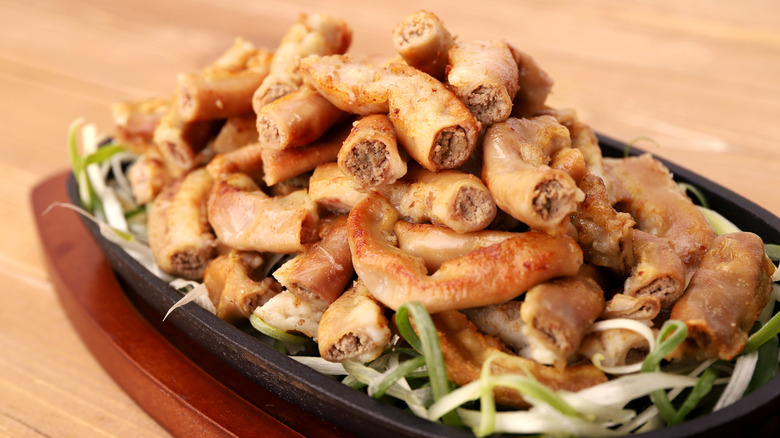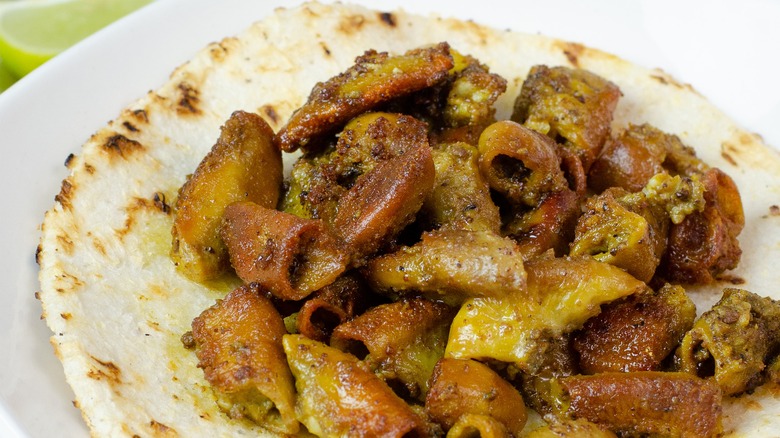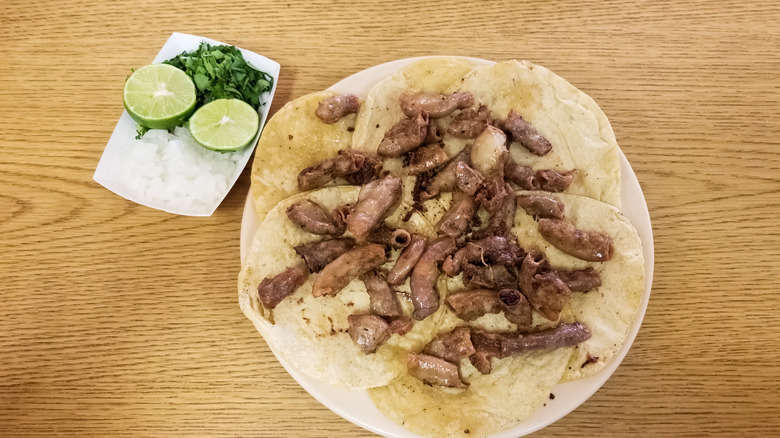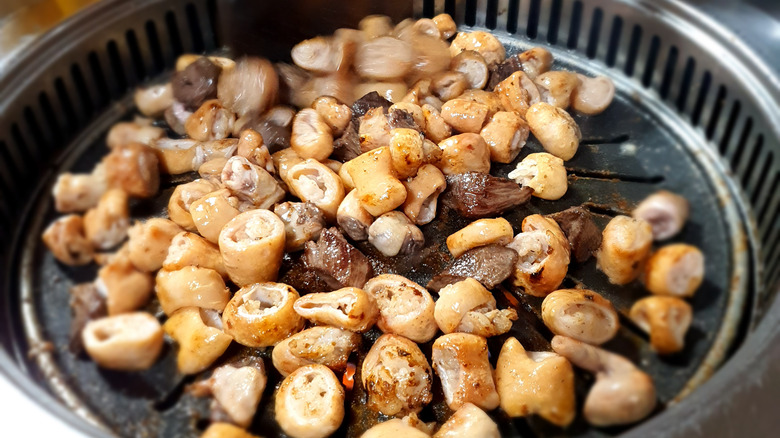What Is Tripas And What Does It Taste Like?
Amidst the plethora of taco offerings, few fillings can match the crispiness of tripas. The tiny chunks — fried to a picture-perfect golden brown — offer that perfect combo of crunchy exterior and soft inside. The taste has a meaty savoriness, with a slightly bittersweet note evoking something similar to sweetbreads. They're made from intestine, usually beef, but sometimes pork or goat, which is an example of an animal cut that may feel intimidating at first but offers a distinctly delicious bite when done right.
In Mexican cuisine, intestines are also utilized for menudo; however, the nourishing soup showcases a completely different part of the animal's organ. Tripas — also known as tripitas — are cut from the small intestine, which has a smooth lining and no honeycomb texture often associated with tripe. Such sourcing lends it a milder flavor and less chewiness, perfect for crisping in a hot pan.
How tripas are prepared
Since tripas are sourced from the digestive tract of an animal, they require several cleaning steps before preparation. First, the intestine is rubbed down with coarse salt to remove any dirt and impurities. Next, it's further scraped with a sharp knife, ensuring there's nothing adhered to a coating. And finally, a vinegar soak utilizes an acidic environment to finalize the cut for cooking. Note that many butchers already sell the cut cleaned.
Before tripas are fried, they're first boiled in order to both cook through the meat, as well as infuse flavor. The boiling liquid usually builds upon an onion, garlic, salt, and dried pepper base, further accentuated with flavorings like cilantro, oregano, coriander, and cloves. The exact constituents are highly malleable, and the flavor can be changed according to one's taste. Depending on the thickness of the tripas, the organ is boiled anywhere from 30 minutes to an hour until it reaches a well-done internal temperature of 160 degrees Fahrenheit. After boiling, the tripas can be stored for up to two days before consumption.
Mexican dishes with tripas
The most popular way to consume tripas is in taco form, a fixture on taqueria menus across Mexico and the U.S. For this crispy application, the boiled intestines are first sliced into small two-inch pieces. They're then traditionally fried using lard in large wok-like pans called discos; however, the cooking can also take place in a pan. After draining some of the excess oil, the tripas are seasoned and placed into a warm corn tortilla. They're often served alongside vegetables, like sautéed peppers, mushrooms, onions, fresh avocado, a vibrant, spicy salsa, and pico de gallo.
In addition to frying, tripas are also grilled on an open flame, as well as baked to a crispy consistency. When not designated for tacos, they're enjoyed as a side dish in a spread of grilled meats. Alternatively, they can also be used as an addition to salsas and guacamole, adding a savory flavor and crunchy textural element.
Tripas in cuisines outside Mexico
In Korean cuisine, the small intestine of pork and beef is consumed in a dish called gopchang. After the cut is painstakingly cleaned, it's sliced into large chunks and seared table side on a high heat, wok-like surface. The crispy bites of the intestine are dipped into a garlic soy-based sauce and cooked alongside vegetables like mushrooms, potatoes, and onions.
Meanwhile, Argentines enjoy beef small intestine as an appetizer at grilling restaurants. Known as chinchulines, the intestine is grilled whole after a soak in a lemon juice-based bath. The result is a mouth-watering crispy and fatty cut of meat accompanied by a chimichurri.
Similar preparations are common throughout other South American countries, too. In Peru — where the dish is called choncholi — the intestine is marinated in a vinegar base alongside chilies, garlic, cumin, and other seasonings. It's then prepped on a hot grill, where the marinade is used as a baste during cooking. In addition to beef, lamb and pork are the most common meat cuts for the dish in Latin America. Regardless of the source meat, location, or preparation, the aim is to bring out the cut's deliciously crispy texture.



